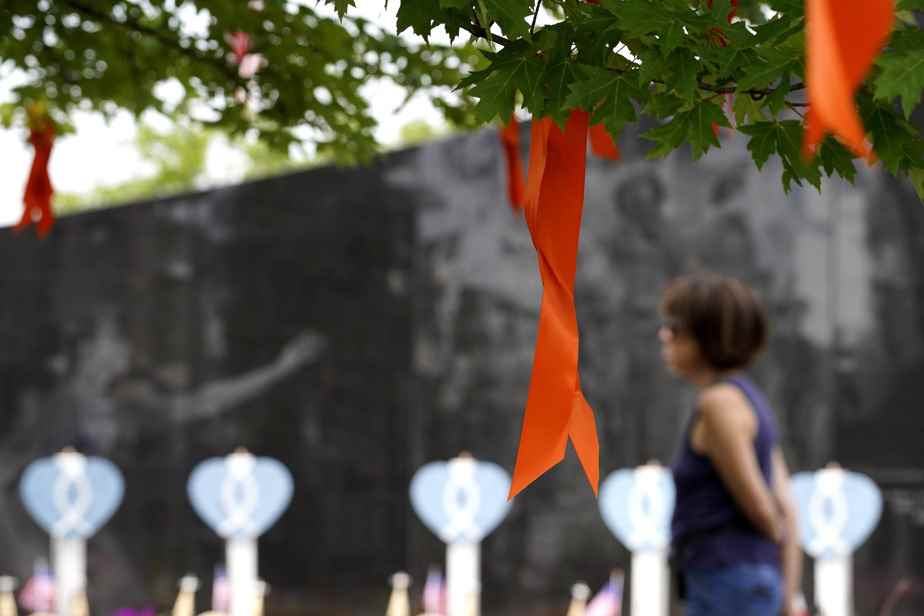(Highland Park) Even some of the strictest gun control laws in the United States are unable to ensure that high-powered assault weapons do not end up in the wrong hands in the State of Illinois.
Posted at 7:56 p.m.
The “red flag law” that allows police to ask a state court to order the temporary removal of firearms from someone they believe may pose a danger to others or themselves , does not ensure either that malicious people possess dangerous weapons.
The problem — part of it at least — is that the state is surrounded in virtually every direction. Wisconsin to the north, Iowa and Missouri to the west, Kentucky to the southeast, and Indiana right next door, sharing not only the shores of Lake Michigan, but a good chunk of the third-largest region as well. Metropolitan of America, Chicago.
Advocacy group Everytown for Gun Safety ranks Illinois sixth among states in the nation for the strength of its gun laws, while the five surrounding states are rated as failing.
The political and cultural character of the United States is only a small part of what makes the gun problem so thorny in the country.
Seven people were killed and 38 people were injured Monday in Highland Park, in a leafy suburb north of Chicago, when a sniper, perched on the roof of a sportswear store and dressed in women’s clothing, used an AR-15 type rifle to fire on parade spectators, unleashing over 80 bullets on the helpless crowd.
“Illinois has pretty strict laws,” said EJ Fagan, a political science professor at the University of Illinois at Chicago.
“The problem is Highland Park is, what, ten miles south of Wisconsin? So even though Illinois has very strict laws, Wisconsin is largely controlled by the Republican Party. »
Chicago — a city notorious for gun violence — suffers greatly from its proximity to Indiana, which ranks 25e on the Everytown for Gun Safety chart because of loose restrictions and a rate of gun violence that has soared 57% over the past 10 years.
Gaps in background checks
Neighboring states, of course, are far from the only problem in Illinois.
The alleged shooter — 21-year-old Robert Crimo, who police say admitted to carrying out the shooting and now faces seven counts of first-degree murder — got his guns in Illinois after her father co-signed her application.
This is despite the fact that the police had already met Mr. Crimo twice: once in April 2019 in response to a suicide attempt, then again in September, when a family member reported that Mr. Crimo had a collection of knives and threatened to “kill everyone”. No charges or complaints have been filed.
Red flag law did not prevent Mr. Crimo from acquiring a powerful weapon. The law only applies if someone goes to court first, in Mr. Crimo’s case no one did.
In a brief phone interview aired Thursday with ABC News, Mr. Crimo’s father, Robert Jr., insisted that encounters with police were minimal and defended his decision to back the gun license application at his son’s fire.
“That’s all it was […] a consent form to allow my son to go through the process, he said. They do background checks. Whatever that implies, I’m not sure exactly. And either you are approved or you are denied. »
Which begs a different question: what good are the rigid gun control measures and red flag laws in Illinois if they couldn’t prevent the July 4 massacre?
Even in states with red flag laws, authorities can’t do much when a responsible adult vouches for their child, said Alexandra Filindra, a politics professor at the University of Illinois at Chicago specializes in gun laws.
“It’s very easy, apparently, for cases like this to slip through the cracks, and we’ll see that happen more and more,” Ms.me Filindra. With 400 million guns in civilian hands, the limited gun control laws we have can’t do much. »
At the federal level, political gridlock in Congress and the grip of gun lobbying on Republicans have made meaningful progress virtually impossible since 1994, when soaring crime rates prompted both sides to impose a ban on ten years on assault weapons that expired ten years later.
But after two fatal shootings earlier in May — first at a supermarket in Buffalo, New York, which killed 10 people, then two weeks later in Uvalde, Texas, where 19 children and two teachers shot — a bipartisan group of U.S. lawmakers came together to pass what some observers have called the most significant gun legislation in a generation.
This included US$750 million for states to run crisis intervention programs, including those that operate with “red flag laws,” as well as courts that specifically deal with veterans and issues. mental health and drugs.
This legislation removed the infamous “boyfriend loophole”, which excluded partners living in a different home from restrictions aimed at disarming anyone convicted of domestic violence.
The new law, signed by President Joe Biden last month, also encourages states to begin including records of minors in the federal criminal background check system.
Even the bill’s advocates have acknowledged it doesn’t go far enough, especially those calling for higher age limits and the restoration of the Bill Clinton-era assault weapons ban now. expired.
“But it’s not nothing,” said Mr. Fagan. There seems to be some consensus developing that states should have more resources to get guns out of the hands of people who obviously shouldn’t have them. »
“I think we should be encouraged by that. This is the most significant bipartisan legislation, essentially, in the modern era of gun laws. »
